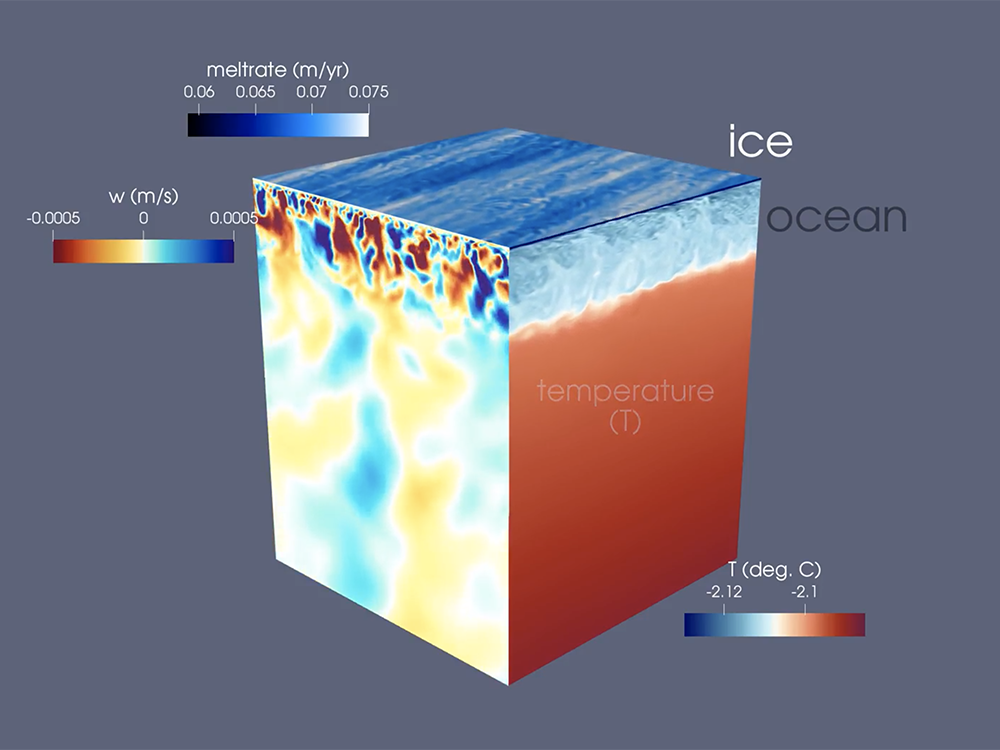Supercomputers simulate Antarctic ice shelf melting
AAPP MEDIA RELEASE
10 February 2021
High-powered physics and supercomputers are helping a team of Australian-based scientists explore the mysterious boundary between Antarctic ice and the Southern Ocean.

The Antarctic Ice Sheet loses about half its mass through ocean-driven melting of its fringing ice shelves.
The inaccessible oceans below Antarctica’s kilometres-thick ice shelves are thought to hold answers to some of the most important global climate questions, including the future of global sea levels.
This deep, cold, dark region has remained frustratingly out-of-reach to scientists due to its extreme remoteness, which also makes it an ideal study subject for supercomputer simulations.
A team of climate modelers and fluid dynamics experts has used Australia’s National Computational Infrastructure (NCI) facility power to achieve a breakthrough in our understanding of the micro-scale processes that melt the ice shelves from below.
The team includes leading glaciologist Dr Ben Galton Fenzi from the Australian Antarctic Division & Australian Antarctic Program Partnership, graduate student Dr. Madi Rosevear from the University of Tasmania and Dr. Bishakhdatta Gayen, an ARC future fellow and senior lecturer from the University of Melbourne,
“Scientists have been to the Moon and explored the depths of the Mariana Trench, but nobody has ever visited the world beneath Antarctica’s ice shelves,” said Dr Galton-Fenzi.
“Supercomputer simulations let us study these remote environments virtually, helping us gain a better understanding of the large-scale physical forces that shape the Earth over time.”
“We know more about the surface of Mars than we do about this critically important part of the global ocean and climate system.”
Lead author of the paper Dr Madi Rosevear said that the team’s discovery overturns one of the major assumptions scientists had about the ocean processes that drive ice shelf melting.
“With very few measurements from beneath ice shelves, our understanding of the processes responsible for ice shelf melting has mostly been cobbled together from observations of other parts of the climate system.”
“Our new research shows that the large-scale movement of water currents beneath the base of an Antarctic ice shelf is not always a key driver of ice shelf melting, as we had assumed”
“We show that a process known as double-diffusive convection is occurring, due to the unique ocean conditions beneath ice shelves, where cold, fresh water sits above warmer, saltier ocean.”
“This is actually a very important piece of the puzzle for climate models, because at the end of the day, it helps us to understand the basic forces that drive sea level rise.” said co-author Dr Gayen.
“This virtual study allows us to push the boundaries of ice-ocean interactions in ways that are next to impossible in the real Antarctic environment. We can isolate the effects of different drivers, such as ocean temperature and the strength of ocean currents.”
The research was supported by the University of Tasmania, University of Melbourne, Indian Institute of Science, Australian Antarctic Division, the Australian Antarctic Program Partnership, NCI supercomputer facility and ARC future fellowship grant.
A copy of the paper is available on the Proceedings of the National Academy of Sciences of the United States of America website.
A short animation illustrating the melting process is below, and available for download here.



